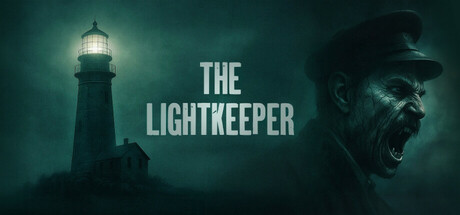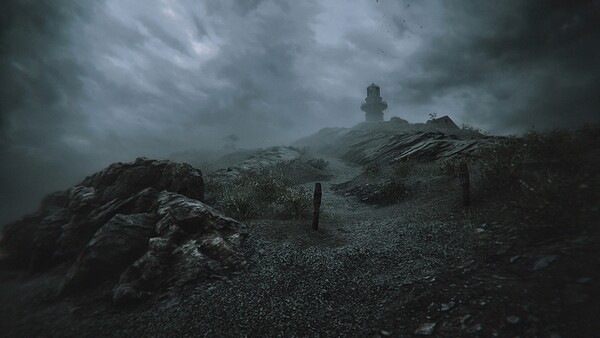Overview
You step into the shoes of Arthur, a World War I veteran who accepts a lonely job as a lighthouse keeper in 1925, hoping to escape his haunted memories. What begins as routine duty soon spirals into psychological torment. On a remote island scarred by the horrific fates of past keepers, Arthur must battle both his fragile mind and the dark truths waiting to surface.
Intro for The Lightkeeper
Short Intro Line
The Lightkeeper is a first-person psychological horror set in the oppressive isolation of the 1920s, where the sea, the past, and the unknown blur into one chilling ordeal.
Content Warning
The game contains realistic depictions of violence, disturbing themes, and references to alcohol and drug abuse. Player discretion is advised.
Info Card (Quick Facts)
Disclosure: “I played the game personally and also used Hollow’s walkthrough (with official permission) for screenshots.”
Title: The Lightkeeper
Developer: Darkphobia Games (Ehsan Jafari & Amir Jafari)
Publisher: Darkphobia Games
Release Date: September 7, 2025
Genre: Adventure, Indie, Psychological Horror
Engine: Unreal Engine 5
Camera: First-Person
Platforms: PC (Steam)
Mode: Single-player
Steam Features: Achievements, Family Sharing
Intro
Personal Lead
Hook Line:
“The solitude of a modern man becomes a dialectic with his own inner self—a desperate attempt to escape the past.”
Why I Chose The Game
I’ve always been in love with horror games, both as a player and as a creator. For years, I’ve followed the work of Darkphobia Games, a studio that has consistently delivered distinct and memorable horror experiences. Horror, to me, is one of humanity’s primal survival mechanisms—when crafted with the right principles, it becomes a powerful medium for storytelling across cinema, literature, and especially games.
I had several reasons for diving into The Lightkeeper. First, Darkphobia’s previous titles already proved their strength in shaping unique horror atmospheres. Second, as a developer myself, I see playing strong horror titles as a necessity to gain ideas and inspiration. Third, every project this studio releases feels distinct, exploring a fresh theme and building fear around it in new ways. Fourth, they manage all of this independently, on limited budgets, while still delivering high-quality results. And finally—perhaps most importantly—this studio is powered by talented Iranian developers, which makes supporting and analyzing their work even more meaningful to me.
First Impressions
Right from the start, the opening cutscenes pulled me in. They didn’t just feel like prologue sequences to a game—they felt cinematic, almost like the opening act of a film you want to follow to the end. It was as if The Lightkeeper promised not only a game, but also a movie-like immersion in fear and atmosphere.
A Standout Early Moment
What struck me most was the soundscape of the island: the relentless crash of waves against the rocks, and most of all, the eerie, resonant horn of the lighthouse. That horn felt like a warning call, vibrating with dread. It didn’t just echo through the island—it echoed inside me, preparing me for a confrontation with something unknown yet terrifying.
Mood Keywords
Loneliness, dread, openness yet confinement, wandering the inner self, dampness, desaturation, the crash of waves against stone.
Game Genres
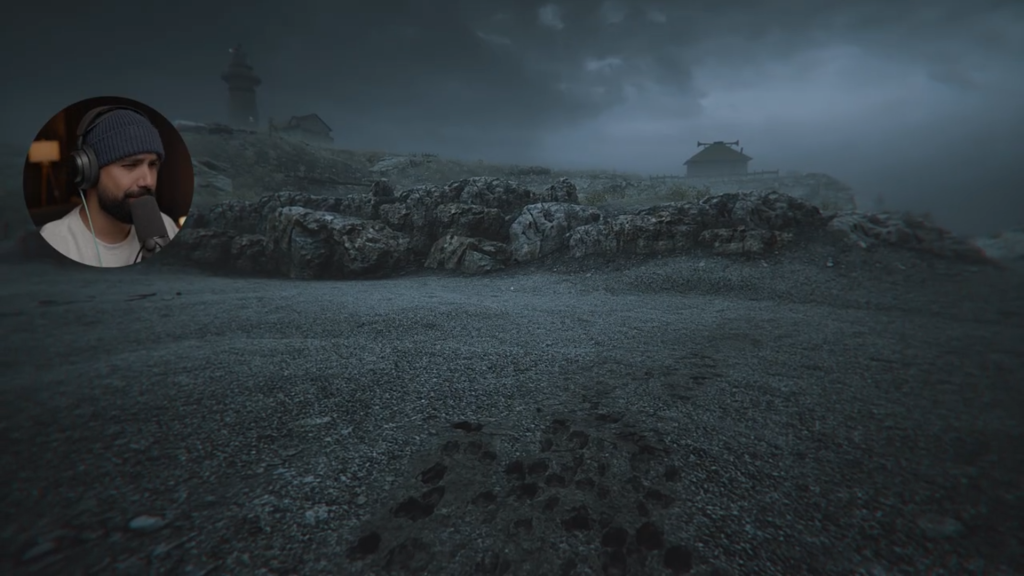
The Lightkeeper stands firmly at the crossroads of horror, psychological thriller, suspense, adventure, and survival. Among these, the psychological horror and suspense elements dominate the experience. What impressed me most was how carefully fear is orchestrated—almost as if drawn on a mathematical curve. Instead of overwhelming the player with immediate jump scares, the game builds tension gradually, releasing it at precise times and places. This engineering of fear feels deliberate and masterful, and it’s a quality that many horror games fail to achieve.
The sense of isolation on the island is especially effective. At first, you seem completely alone, but the deeper you go, the more you realize you’re not. That creeping awareness is a classic horror device, and here it pays tribute to the genre with elegance.
On the survival side, the game flirts with mechanics but doesn’t fully commit. For instance, at one point you reach the radio station to request rescue, only to be denied regardless of your choices. Both options—leaving or staying—lead to the same outcome: remaining trapped. While this might feel limiting from a survival standpoint, it simultaneously introduces a different form of horror and suspense. The player is forced to accept helplessness, which is itself a powerful tool of fear.
Score: 9 / 10
Camera Perspectives in Games
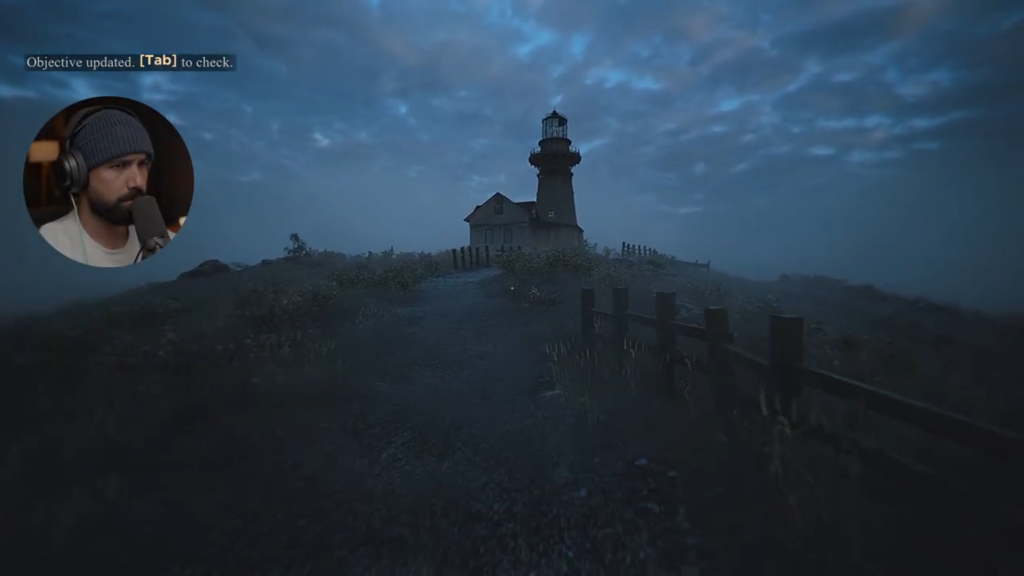
The first-person perspective in The Lightkeeper feels familiar and conventional. It’s similar to what we’ve seen not only in Darkphobia’s earlier titles but also in many other first-person horror games. This doesn’t make it bad—far from it. The perspective is standard, reliable, and functional, but it doesn’t introduce anything particularly innovative or memorable in terms of point of view.
From a technical standpoint, camera control is smooth and responsive. I never felt restricted or uncomfortable while exploring the island. However, I did notice minor inconsistencies, particularly when interacting with animations—for example, filling the oil container sometimes caused abrupt shifts. There was also a slight dissonance between walking animations and camera movement in certain sections, where the sense of “weight” in footsteps wasn’t fully conveyed.
In terms of contributing to fear, I would say the camera accounts for roughly 30% of the tension. It does its job, but it never becomes an active instrument of horror. To illustrate: in a game like Don’t Scream, the camera itself becomes part of the terror through its fluidity, weightlessness, and uncanny realism during head turns. The Lightkeeper’s camera, by contrast, plays it safe.
On the positive side, there were no major bugs or disruptive issues that broke immersion. It functions as a solid lens through which the rest of the game unfolds.
Score: 7 / 10
Game Art Styles

The color palette of The Lightkeeper is carefully chosen and deeply aligned with its genre. Muted tones, desaturated environments, and damp textures all blend seamlessly with the atmosphere, creating a sense of cohesion. Nothing feels visually out of place; the harmony between environment design and material choice results in a balanced, immersive world without jarring elements.
The visual style is best described as realistic, not hyper-realistic. This distinction is important, and one that is often overlooked. Realism aims to create believability, while photorealism (or hyper-realism) seeks to replicate reality down to microscopic detail. The Lightkeeper does not claim to be photorealistic, nor should it. It succeeds in creating a convincing realistic style that supports immersion without overreaching. As someone whose background is in hyper-realistic rendering, I can confidently say this game achieves realism at a high standard, but it doesn’t attempt photorealism—and that’s perfectly fine.
Every area of the game demonstrates this style effectively, but the lighthouse interior stands out. The staircases winding upward toward the lantern chamber were both visually striking and atmospherically powerful. They encapsulated the feeling of ascending into something both sacred and terrifying.
Minor issues exist—such as some repetition in textures within the lighthouse interior and slight mismatches between texture and model. Yet these details are negligible, almost invisible to the untrained eye, and they never break immersion.
Score: 9 / 10
Core Gameplay Elements
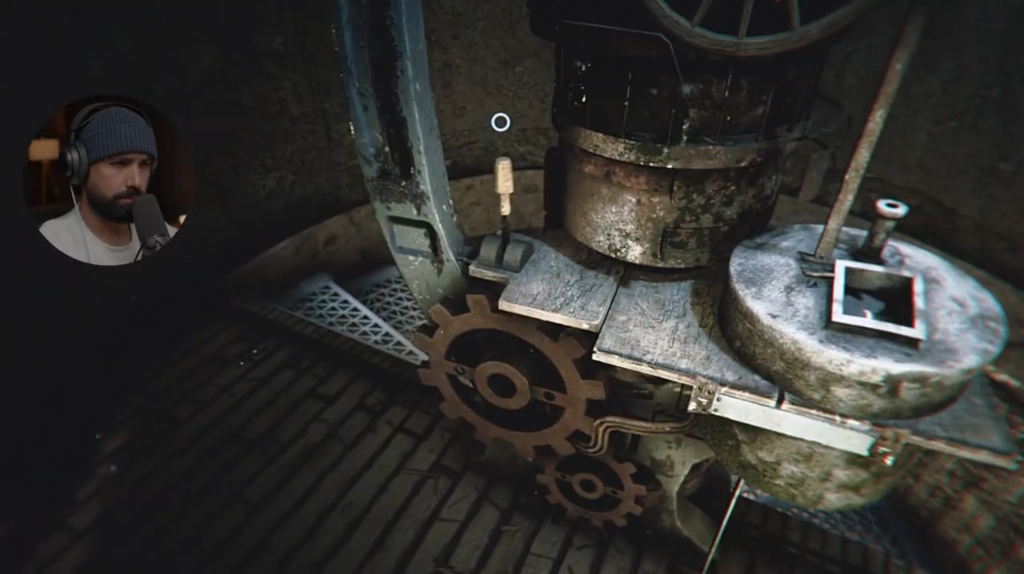
At its core, The Lightkeeper revolves around a loop of light and sound: managing the lighthouse beacon and the island’s foghorn. The mechanic is deceptively simple: when the beacon is lit, the horn must be silenced, and when the beacon is off, the horn must sound. This back-and-forth pulls the player constantly between two points—the lighthouse and the foghorn station.
What elevates this loop is not the routine itself, but what happens along the journey between these locations. The walk from point A to point B becomes a stage for new scenarios, scares, and discoveries. By the time the loop finally breaks near the game’s conclusion, it feels purposeful, even poetic. You realize that the entire game has been about being caught between light and sound, or in a more symbolic sense: suspended between silence and noise, darkness and illumination.
This mechanic works because of how deliberately it’s framed. Knowing when, where, and how to disrupt the loop becomes a key storytelling device, and here it’s executed with precision.
The only potential drawback is the distance between the two points. For some players, this might feel tedious. Yet in the context of horror design, this repetition can serve as a tool—creating unease, frustration, and claustrophobic dread even in open space. Horror isn’t about making the player comfortable; it’s about keeping them anxious, and in that sense, the design succeeds. Importantly, the pacing feels balanced: never too shallow, never unbearably stretched.
Score: 7.5 / 10
Game Engines Explained (Engine Use)

When it comes to the choice of engine, The Lightkeeper makes it clear: Darkphobia Games know Unreal Engine inside and out. As someone who has spent nearly a decade teaching and practicing modeling, texturing, and rendering through my background in architecture, I can usually tell whether a team is amateur or professional just by looking at the final product. In this case, the verdict is obvious—the developers truly understand Unreal Engine and know how to bend it to their will. With such a powerful engine, expectations for visual and technical quality are naturally high, and Darkphobia has consistently met those expectations in this and their previous titles.
In terms of optimization, performance is solid, though it’s important to remember that frame rate, smoothness, and minor stutters are always 50% dependent on the player’s hardware and 50% on the developer’s optimization. With a storage requirement of 15 GB on Steam, the game feels well-optimized for its scale. Models and textures are clean, efficient, and never betray obvious visual shortcuts. Unreal itself is a heavy engine, so some degree of demand is inevitable. For comparison, a game like Don’t Scream clocks in at about 16 GB, featuring much larger landscapes and hyper-detailed assets. Within that context, The Lightkeeper’s footprint is acceptable—especially considering Darkphobia is an indie team working under budget constraints.
Loading times and cutscenes were handled impressively. On my system, they ran smoothly, and importantly, all cutscenes are rendered in real time, not pre-rendered video files. This is a testament to the team’s technical command of Unreal.
The lighting system and the mechanics implemented through Unreal stood out as particularly strong. That said, I did notice a single instance in the lighthouse hallway where a spotlight was used without a visible source—clearly a design decision to illuminate the space. Casual players wouldn’t notice it, but to developers and specialists, it stands out. Still, this is a minor detail in an otherwise technically impressive implementation.
Game Design
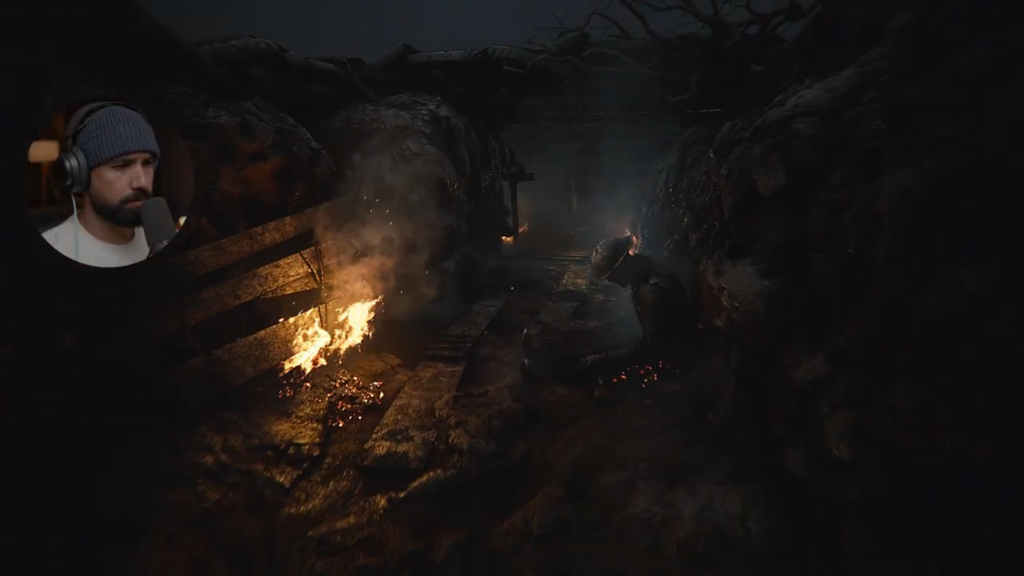
The design of The Lightkeeper feels deliberate and carefully engineered. Nothing in the experience feels out of place or meaningless; every element contributes to the whole. Above all, this is one of Darkphobia’s most narrative-driven titles, and the studio remains faithful to the story it set out to tell. With three different endings, the game demonstrates ambition that is particularly impressive for an indie studio. In fact, The Lightkeeper shows that Darkphobia has reached a new level of maturity in creating games that could stand alongside international standards—despite being a small independent team.
In terms of balance, puzzles and challenges never felt overwhelming, but neither were they overly simple. There were moments where puzzle design leaned toward convenience rather than depth—for example, in the soldiers’ dormitory, moving a picture frame revealed a blatant arrow hinting at something hidden under a pillow. These instances risk breaking immersion, but they are forgivable given the broader context of the game’s ambitions.
Progression feels harmonized across the board. There’s a clear harmony between genre, level design, art style, narrative, direction, sound, and mechanics. That said, Darkphobia hasn’t yet developed a fully recognizable “signature style” that makes you instantly say, this is a Darkphobia game. However, with The Lightkeeper, they are undoubtedly on the verge of achieving that identity.
The game sustains suspense and fear throughout, but shifts the tools it uses to achieve them: sometimes through jump scares, sometimes through dialogue, sometimes via mechanics, sound, lighting, or puzzles. This variety keeps the horror balanced and prevents reliance on a single technique.
The main weakness lies again in some puzzle design. A few feel like simple triggers to unlock the next quest rather than meaningful challenges. Still, considering the studio’s independent status and their impressive ability to release games annually, this shortcoming is understandable—and even commendable in context.
Score: 7 / 10
Game Direction
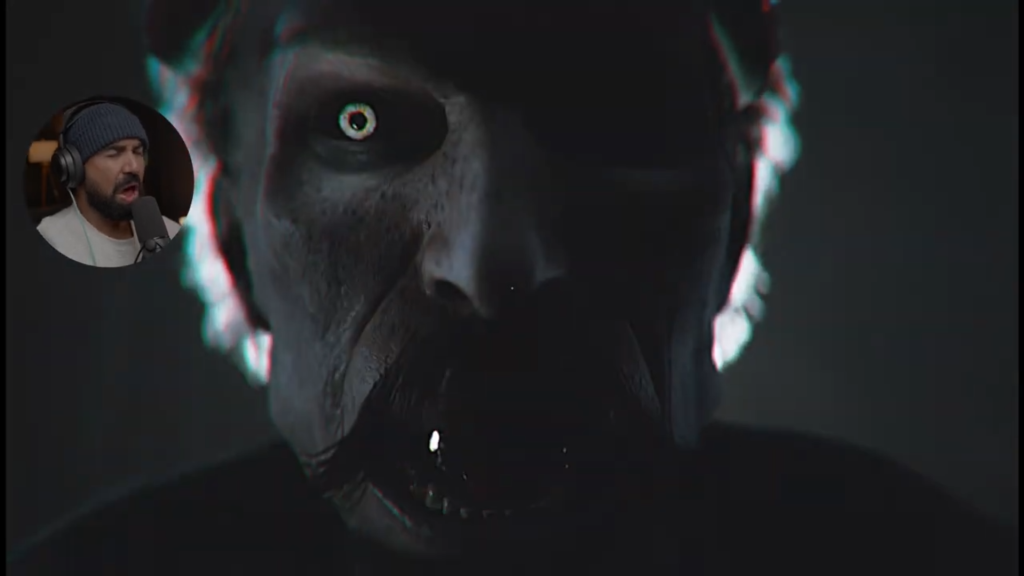
The direction of The Lightkeeper is deliberate and structured, beginning with a cinematic prologue that sets the tone perfectly. Before even stepping into gameplay, the opening cutscenes establish where you’re going, though not what will happen—an effective way to prime the player’s imagination without revealing too much.
Directing fear in horror games is notoriously difficult. Many titles lean too heavily on jump scares, flooding the player with them until the effect wears off within minutes. The Lightkeeper avoids this trap at first. The very first jump scare is placed with precision—arriving exactly when you least expect it. Personally, it hit so hard on the bridge sequence that I literally shouted and nearly fell out of my chair. That’s how you know a scare is well executed. Later in the game, however, the jump scares lose some of their punch, with a slight drop in quality. Still, fear and suspense are maintained through other means—sound, lighting, mechanics, and dialogue. Importantly, horror here is not reduced to jump scares alone, which is a lesson many horror developers could take to heart.
Scene variety increases as the game progresses, though not always in the most impactful ways. For instance, the war trenches sequence is beautifully designed, with intricate detail and immersive atmosphere. Yet, its potential is underused—the environment functions more like a maze to navigate than a fully integrated storytelling device. The design is impressive, but the gameplay payoff feels limited.
Overall, the pacing of fear feels engineered—almost mathematical in its rhythm. The tension graph rises and falls in a way that feels intentional and mostly effective. While a few scares might come too suddenly or feel unnecessary, the majority are well-placed and unpredictable, especially in the early stages.
Score: 7 / 10
Level Design
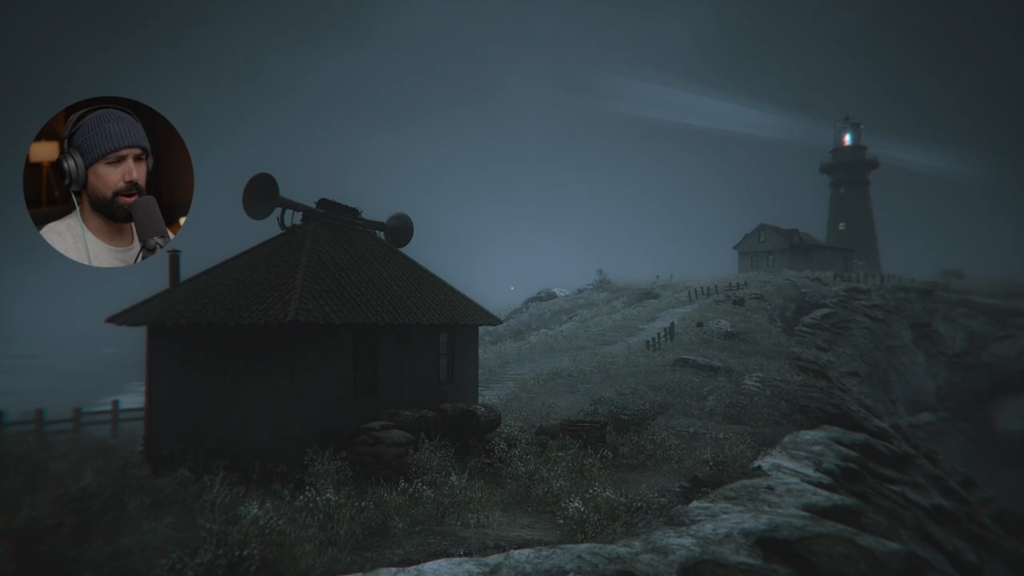
What immediately stood out to me in The Lightkeeper was how the environment avoided the flat, horizontal layouts that plague many games—even across genres. Instead, the landscape embraces topology and topography: organic slopes, inclines, and uneven ground. As someone trained in architecture, I can say with confidence that the environment design feels both organic and deliberate, with visual harmony between landmarks and structures. Distances between key points are measured and intentional, making traversal both engaging and believable. Many games rely on flat terrain, which becomes monotonous, but here the landscape breathes—it’s alive, textured, and visually rewarding.
In horror and puzzle-driven survival games, a degree of confusion is necessary by design. But it’s critical to distinguish between intentional ambiguity and sloppiness. Darkphobia handles this distinction well in The Lightkeeper. Ambiguity is deployed thoughtfully, maintaining mystery without descending into chaos. For example, in their earlier title Homeless, some underground sections leaned closer to disorder. Here, ambiguity is used artfully to unsettle without frustrating. That said, I did notice one oversight: it was possible to bypass intended paths and reach the boat house by climbing over rocks outside the designed route, suggesting missing collision boundaries rather than intentional design.
Exploration in interiors is less compelling. Internal spaces mostly serve the narrative directly, with little sense of discovery beyond their scripted purposes. The outdoor landscapes, however, are far more engaging, delivering moments of visual beauty and environmental storytelling.
Architecturally, proportions and composition are strong throughout. The lighthouse is the most striking landmark, naturally, but I was also drawn to the statue in the water, designed as part of an achievement. Still, interiors lack independent identity; they support the scenario but rarely stand out as memorable spaces in their own right—a natural tradeoff in horror design.
The main criticisms lie in those interior spaces, which could have offered deeper exploration, and the war trench sequence, which—despite strong visuals—functions primarily as a maze rather than an integrated narrative space.
Score: 7 / 10
Narrative Design

Unlike Darkphobia’s earlier titles, The Lightkeeper feels fully narrative-driven—and that shift makes all the difference. In previous games, the story often functioned as a framework to justify gameplay, but here, the story is the game. It grips you, not simply for the dopamine rush of completing objectives, but because you genuinely want to know what happens next. The central mystery compels you forward, and finishing the game feels inseparable from uncovering its truth.
When it comes to environmental storytelling, the game leans more on direct cues—notes, written texts, or dialogue triggers—rather than subtle, indirect discovery. This is a structural limitation found in many games across genres, and The Lightkeeper is not exempt. Personally, I believe that the strongest storytelling often comes through environmental hints that players deduce on their own, not only through explicit markers. It’s a challenge I face in my own development work, and one I discuss often with my students. While the approach here works, it could be refined to reward more organic discovery.
On the other hand, dialogues and monologues are well-crafted. Arthur’s moments of speaking to himself add depth to his fragile psyche, and it’s clear these lines were written with care rather than treated as filler.
Thematically, the game succeeds. Each theme—war trauma, isolation, delusion, the fragility of the human mind—lands with cohesion. What resonated most for me was the portrayal of contemporary loneliness and inner exile. This is where the narrative feels not only chilling but also profound.
Structurally, I found no real weakness in the writing. It’s important to emphasize: we’re dealing with a video game, not a film, and the writing embraces the interactive medium instead of competing with cinema. Some external commentary has accused the game of copying or borrowing heavily from The Lighthouse (2019 film). I reject that notion entirely. Inspiration and plagiarism are worlds apart, and recognizing that distinction requires literacy in cinema, game design, and art—something many casual players understandably lack.
Score: 10 / 10
Environment Art
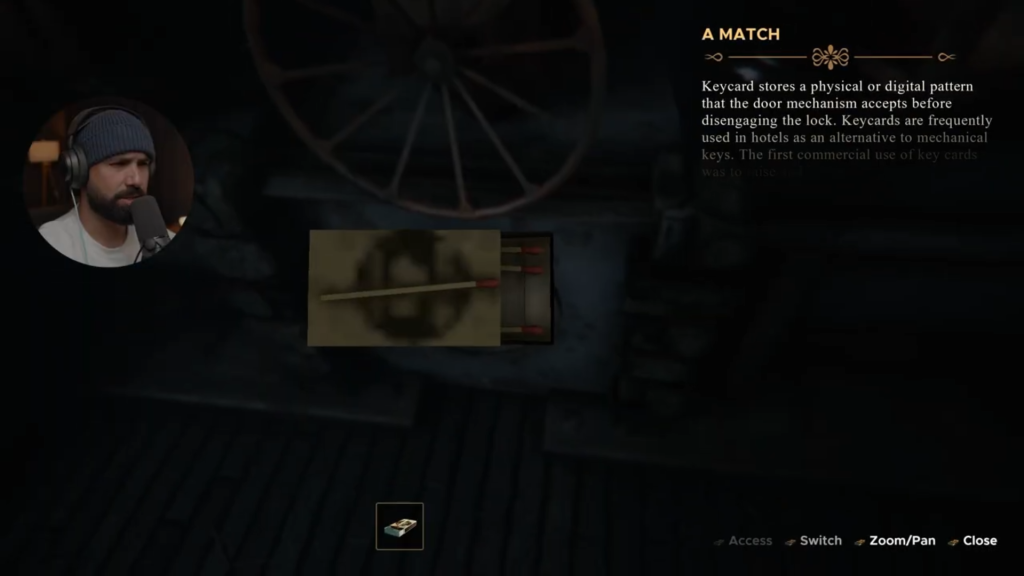
From a modeling and texturing standpoint, the environments in The Lightkeeper are functional but uneven. While some areas meet expectations, others fall short of the studio’s previous standards. As I mentioned earlier in the level design section, when architectural spaces lack identity, the visual burden falls on surface-level elements—textures and materials. In this regard, the game often feels inconsistent.
For comparison, Darkphobia’s earlier project set in the Egyptian pyramids had excellent environmental textures, whether built from scratch or sourced from pre-made blocks. In The Lightkeeper, however, many textures feel amateurishly applied, as though generated quickly in Substance Painter with dirt and grunge layers piled on for atmosphere. The intent—to convey decay, fear, and age—is clear, but the execution sometimes undermines the immersion. It’s not outright poor, but relative to the studio’s own track record, it is noticeably weaker.
The lighthouse chamber stands out as the one environment with true architectural and spatial identity. It’s visually striking and feels like a centerpiece. The rest of the spaces, however, serve more as functional backdrops than as memorable locations in their own right.
Another point is the style of props and environmental objects—grass, plants, oil cans, furniture—which often lean closer to a stylized art style than realism. Whether this is due to baked lighting in certain sections or simply the choice of assets, some elements look artificial, clashing with the overall realistic tone.
That said, the outdoor environments are a highlight. The island itself feels expansive and alive, with strong topographical variety. Yet, even here, some texture boundaries are too sharp, particularly where roads meet the surrounding terrain. Casual players likely won’t notice, but to a trained eye, these seams stand out.
Score: 6 / 10
Character Art
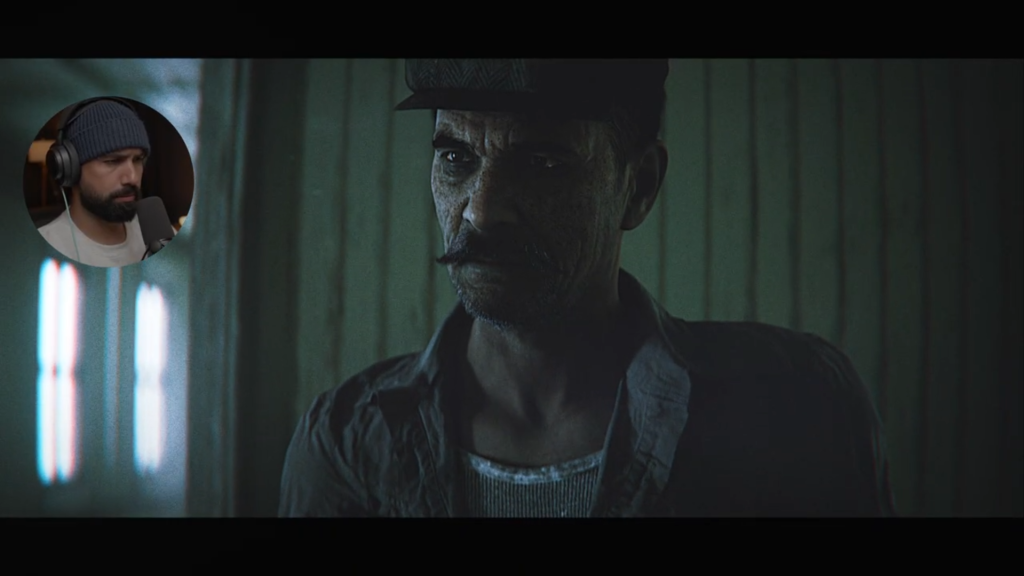
One of the strongest aspects of The Lightkeeper lies in its character design. Without exaggeration, the characters are modeled and textured with clear attention to detail. Compared to Darkphobia’s earlier projects, the leap in quality is undeniable. It’s evident that the team has learned from past shortcomings and deliberately worked to improve. In this area, they truly delivered.
The human characters beyond Arthur are also convincingly realized, though not all creatures fare equally well. For instance, the birds—particularly crows—felt less polished. To be fair, many indie studios, including Darkphobia, often rely on marketplace assets for secondary creatures, and that’s not unusual. Even I’ve purchased the same crow asset for my own project. Independent teams cannot be compared to AAA giants like Rockstar; the fact that they deliver such high-quality human characters at all is already commendable.
Readability and silhouette are excellent. Facial rigs show that serious effort went into achieving believability. This marks a clear improvement from earlier titles like Night Shift, where character rigs often looked stiff or mannequin-like. Here, the results are leagues ahead.
Facial expressions and rigging are particularly impressive. Animation quality is solid—above average but not flawless. Movements sometimes fall short of cinematic realism, yet they remain immersive and believable enough to avoid distraction.
Overall, this is a standout achievement for Darkphobia.
Score: 9.5 / 10
Animation
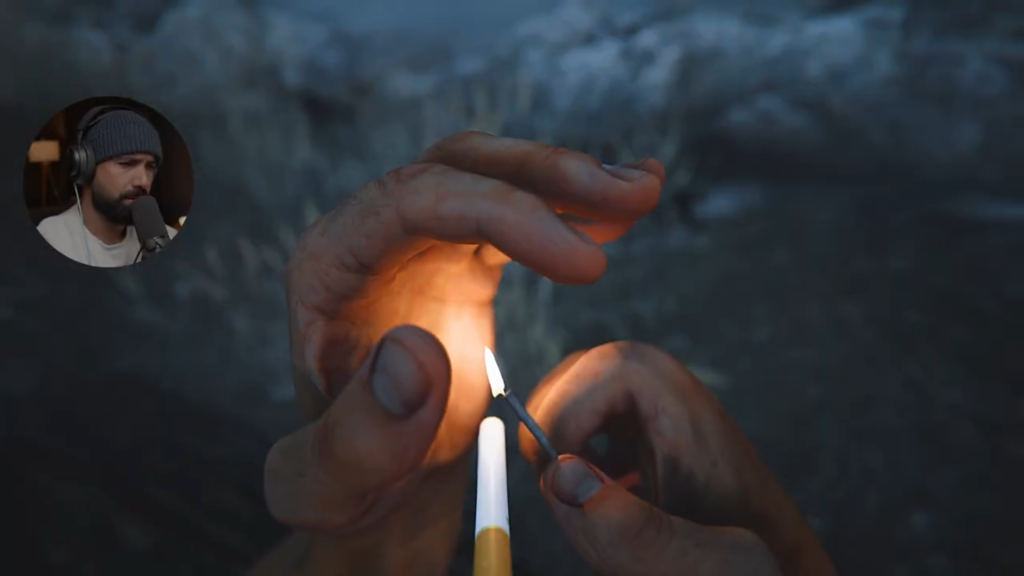
The Lightkeeper is not heavily animation-driven, but the moments it does focus on animation are handled with care. Most of the work is seen in the cutscenes, where character animations are smooth, natural, and effective in delivering narrative weight.
For transitions, the execution is solid overall. Actions such as interacting with objects feel believable, with one notable exception: when filling the oil container for the lighthouse flame, the liquid visibly leaks from beneath the asset in an unnatural way. It’s a minor flaw, but noticeable to attentive players.
Rigging and facial expressions are clearly given attention. Subtle changes in Arthur’s face across different atmospheres reinforce immersion and reveal that time and effort went into this aspect.
Two animations stood out as particularly memorable: the smoking sequence, which added a humanizing detail, and the crow attack, which carried sharp intensity.
The only disruption I encountered was a sudden frame stutter when waking from a dream sequence. Lighting took a moment to load back in, though this may have been a limitation of processing rather than the game itself.
Overall, animation is not the core strength of the game, but where it matters, it delivers convincingly.
Score: 7 / 10
Lighting Art
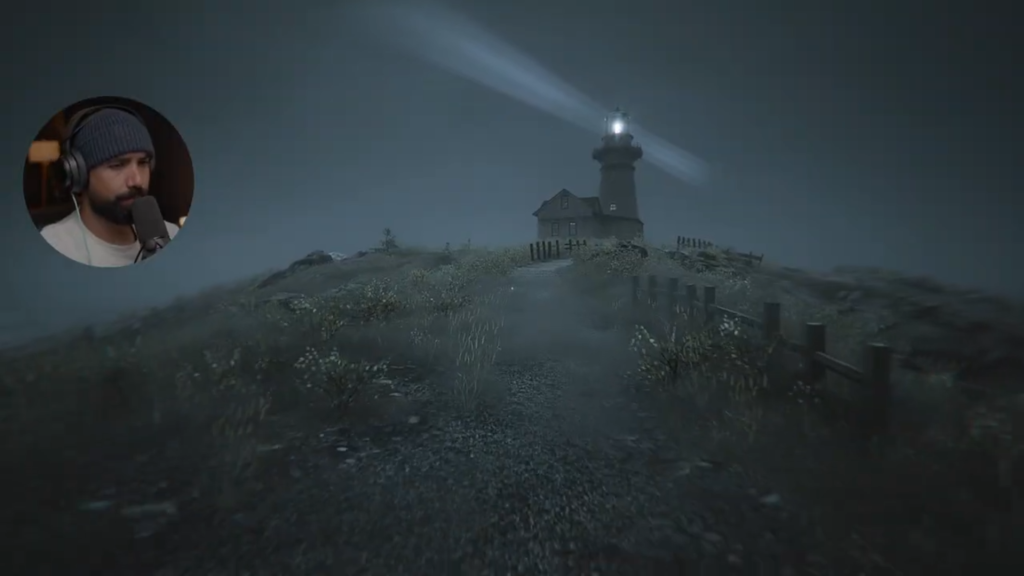
I found the outdoor lighting and atmosphere more effective than the interiors. Unreal Engine is a powerful tool for lighting, but its strength comes with the challenge of fine control. In a horror game, the goal isn’t beauty or spectacle—it’s mood. Outdoors, the cloudy skies created an oppressive gloom that worked well. Indoors, the lighting was average to solid, functional but not extraordinary.
Shadows were less of a defining feature in this game. Because the island is constantly overcast, dramatic shadow play was limited. Interiors also didn’t provide strong architectural opportunities for shadow-driven storytelling, so this aspect remained subdued.
For most of the experience, lighting served simply to illuminate or darken spaces, rather than to guide the player. Roughly 80% of the time, the lights functioned as switches rather than narrative cues.
The standout moment was in the war trench simulation, where lighting gave the scene a cinematic feel. Combined with the abundance of late-game cutscenes, the game often began to resemble a film more than a traditional horror title—though in a positive way.
One major omission in lighting design was the flashlight. While it exists in the game, its use is extremely limited—so much so that you could complete the game without ever feeling the need for it. More critically, the player has no control over the flashlight: it turns on and off automatically depending on context. This removes one of horror’s most iconic mechanics—the tension of choosing when and how to use light in darkness—and denies the player the pleasure of wielding it as a tool for exploration.
The biggest weakness I observed overall was the lighthouse beam itself. Instead of scattering naturally across the island, it projected in a linear, artificial way that felt unrealistic. Perhaps this was a performance optimization choice, but visually it stood out as unnatural and broke immersion.
Score: 6 / 10
Sound Design
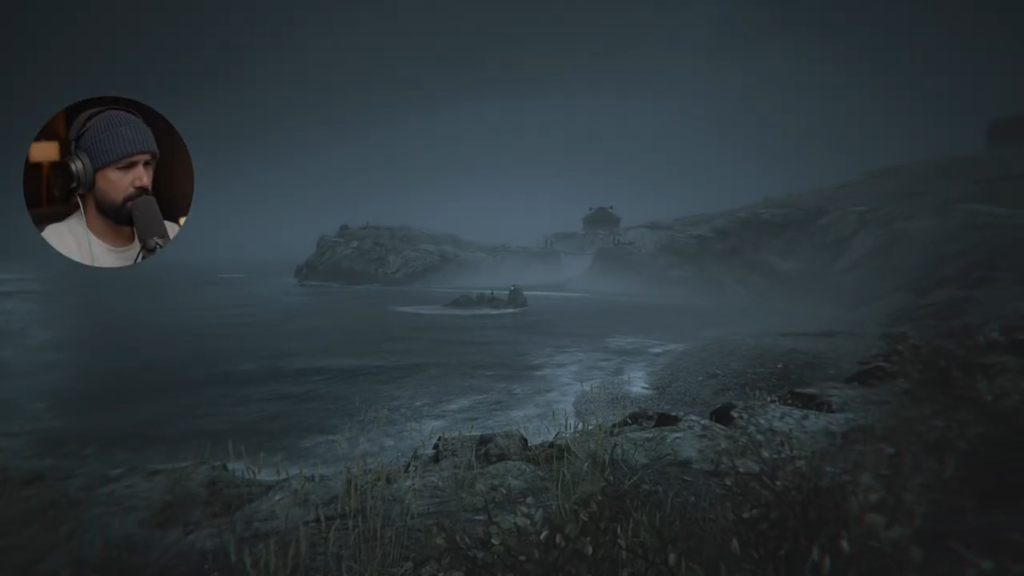
One of The Lightkeeper’s strongest achievements is its sound design and music. Both are seamlessly woven into the experience, aligning perfectly with the genre, style, and narrative. Nothing ever feels out of place. Even when the music shifts, the transitions are so smooth that you don’t notice abrupt changes—the rises and falls flow as a unified whole.
The background music is subtle and understated, but it fulfills its role brilliantly: maintaining an atmosphere of dread and unease while never distracting from the experience.
The voice work is equally effective. Character voices feel natural, well-cast, and tonally appropriate—never breaking immersion or sounding forced.
Sound plays a massive role in the game’s horror delivery, especially in jump scare moments where audio cues heighten the impact. This attention to sound design ensures that the game sustains tension without relying solely on visuals.
I found no notable weaknesses, either technical or artistic. Horror as a genre lives or dies by its audio. A game can survive weaker visuals or mechanics, but if its sound design fails, the entire experience collapses. Darkphobia seems fully aware of this, as The Lightkeeper executes sound design with mastery, just as they have in their earlier titles.
Score: 10 / 10
UI/UX
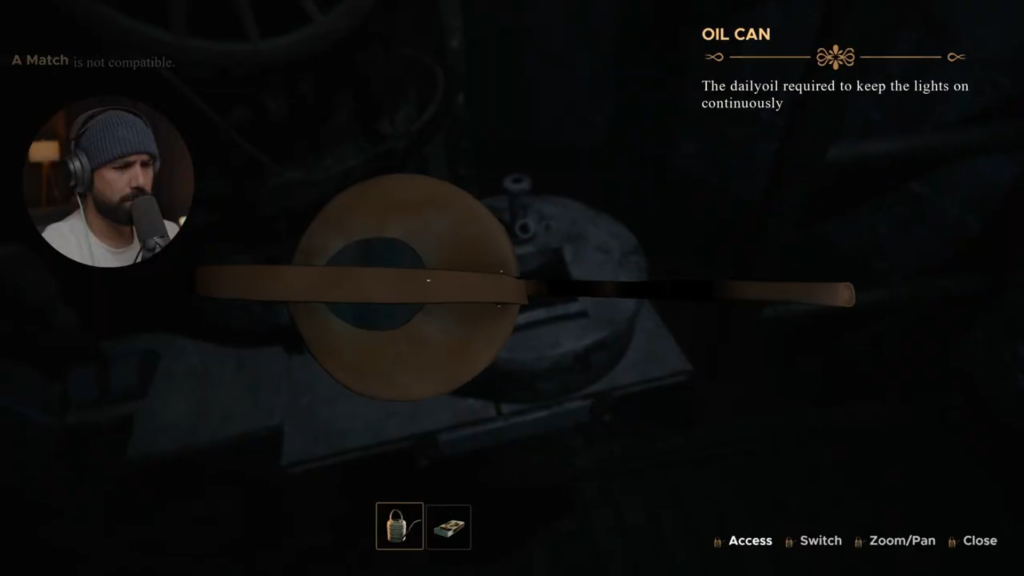
The menus in The Lightkeeper are well-designed, clean, and fully legible. They don’t overwhelm the player with clutter, nor do they feel underdeveloped. There’s nothing particularly innovative in the UI, but that isn’t a flaw—sometimes standard design is the right choice, and here it works.
The controls are straightforward and responsive. Everything feels natural, with no unnecessary complexity.
The game does feature an inventory system, but this is where some rough edges appear. At times, selecting specific objects—like a key you’ve found—felt unintuitive and slightly confusing. To be fair, this game didn’t really need an inventory system at all. Often, indie studios include certain mechanics not out of necessity, but as a way of demonstrating technical ability or expanding their portfolio. I’ve done the same in my own projects: adding mechanics that serve more as a showcase than a requirement for gameplay.
The main artistic critique is that the UI doesn’t strongly harmonize with the game’s atmosphere. Functionally it works, but visually it doesn’t feel deeply integrated into the horror aesthetic.
From a usability standpoint, there are no glaring weaknesses, but from an artistic perspective, it lacks cohesion with the rest of the game.
Score: 6 / 10
Mechanics
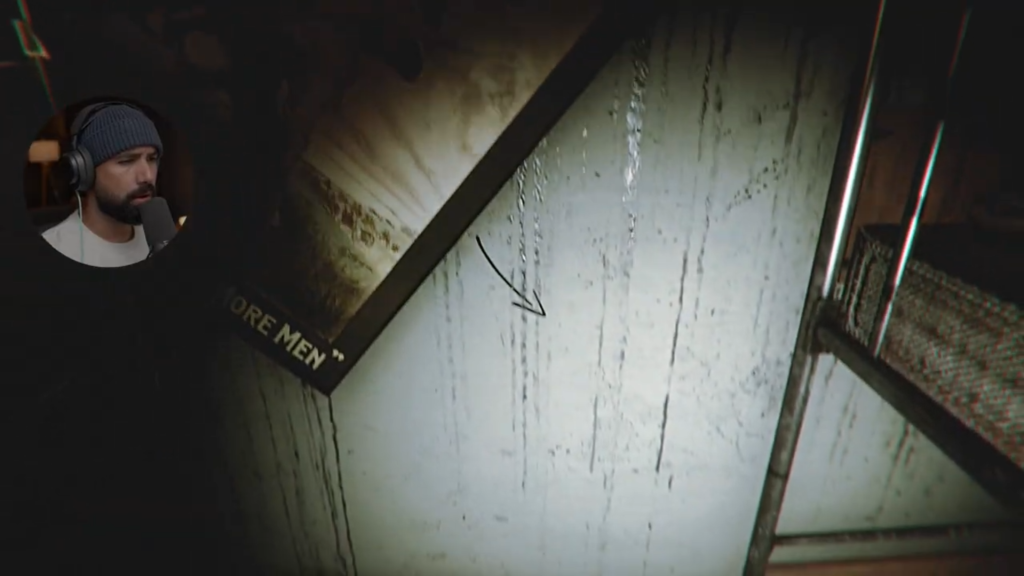
Mechanics are often the backstage architecture of game design—difficult to create but easy to overlook in the final product. In The Lightkeeper, the mechanics are kept deliberately simple, and honestly, the game doesn’t need more. There’s no standout innovation like Kratos’ axe in God of War, but this title never aimed for that. Its horror lies in atmosphere and narrative, not complex systems.
The available mechanics do have some variety, but the genre itself limits how far they can go. Interactions are mostly straightforward: filling the lighthouse lamp with oil, striking a match to light the fireplace, or pulling a lever. These are functional rather than mechanical puzzles, existing to move the player from one narrative point to the next rather than to challenge their problem-solving skills.
Unfortunately, mechanics here rarely serve fear or suspense directly. They exist more as progression triggers than as horror amplifiers. A few lighter mechanics—like moving a picture frame or opening windows in a hallway—add atmosphere but lack depth.
The most memorable moment for me was a hallway sequence where walls began shifting and closing in. While more of a scripted animation than an interactive mechanic, it created a powerful sense of dread. It’s a reminder that mechanics don’t always have to be player-driven to be impactful.
Overall, the mechanics are serviceable but not remarkable. They support the game’s story and atmosphere without shining on their own.
Score: 5.5 / 10
“Perspective and Criteria Behind the Scores”
Before diving into the final score table, it’s important to clarify the perspective and methodology behind my evaluation of The Lightkeeper. This review was written not only from the point of view of a player experiencing the game’s atmosphere, tension, and story, but also from the perspective of a game developer who understands the design process, technical limitations, and artistic choices involved.
The scoring is therefore based on two layers:
- Player experience → how immersive, entertaining, and frightening the game feels moment to moment.
- Developer insight → how well the mechanics, visuals, sound, and design decisions hold up when analyzed critically in the context of indie development, technical execution, and genre conventions.
Each category was judged on its relevance to the horror genre, execution quality, creativity, and consistency. Scores are not just arbitrary numbers but reflect a balance between artistic achievement, technical execution, and experiential impact.
With this framework in mind, the table below summarizes my detailed breakdown of The Lightkeeper.
Final Score Table
Perspective and Criteria Behind the Scores
(as explained above — combining both player experience and developer insight)
| Category | Score (/10) |
|---|---|
| Game Genres | 9.0 |
| Camera Perspectives | 7.0 |
| Game Art Styles | 9.0 |
| Core Gameplay Elements | 7.5 |
| Game Engines Explained | 8.0 |
| Game Design | 7.0 |
| Game Direction | 7.0 |
| Level Design | 7.0 |
| Narrative Design | 10.0 |
| Environment Art | 6.0 |
| Character Art | 9.5 |
| Animation | 7.0 |
| Lighting Art | 6.0 |
| Sound Design | 10.0 |
| UI/UX | 6.0 |
| Mechanics | 5.5 |
Final Verdict
The Lightkeeper is more than just another indie horror game—it’s a testament to what a small, independent team can achieve with vision, persistence, and mastery of their tools. Darkphobia Games has created an experience that combines psychological horror, atmospheric storytelling, and immersive sound design with a level of polish that positions them among global indie developers, despite working with limited resources.
From a player’s perspective, the game succeeds in sustaining tension, delivering memorable jump scares, and immersing you in Arthur’s lonely struggle on the island. From a developer’s perspective, it showcases an indie studio steadily maturing, learning from past projects, and pushing toward its own creative signature.
The game is not flawless—issues in mechanics, UI/UX, and environment art sometimes hold it back—but its strengths in narrative design, sound design, and character art far outweigh these shortcomings. The Lightkeeper stands as a remarkable example of indie horror done right, and a project that deserves both recognition and support.
TL;DR
The Lightkeeper is an atmospheric psychological horror from Darkphobia Games that excels in story, sound, and character design, while showing room for growth in mechanics and UI. As both a player and a game developer, I consider it one of the most impressive indie horror titles of recent years.
Final Overall Score: 7.6 / 10
Author: Pouria Mojdeh — Architect, Independent Game Developer, University Lecturer
Disclaimer: Unauthorized use of this material without citing the original source is strictly prohibited.

